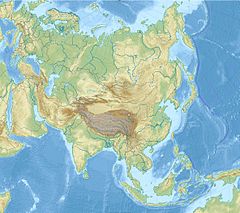The Mahanavika Buddhagupta ("Great Navigator Buddhagupta") stone inscription, is a 5th-century CE Buddhist stone inscription found in the Wellesley Province, Penang, Malaysia. It was discovered in 1834 by Captain James Low, of the East India Company.[1]
| Mahanavika Buddhagupta inscription | |
|---|---|
 Rubbing of the Mahanavika Buddhagupta stone inscription, 5th century CE, Indian Museum, Kolkata | |
| Material | Schist |
| Size | 8-9 cm x 66 cm |
| Created | 5th century CE |
| Discovered | Wellesley Province, Penang, Malaysia |
| Present location | Indian Museum, Kolkata |
The plaque is in schist, 8–9 cm wide, and 66 cm high.[1] It is today in the Indian Museum in Kolkata.[1]
The plate features the illustration of a Buddhist stupa.[1] The script is Brahmi from South India, and very similar to the script of the inscription of King Purnavarman.[1] Buddhagupta declares in his inscription that he is from Raktamartikka, thought to be Rajbadidanga in Bengal.[1]
The stele examplifies the links between India and Southeast Asia and that early time, as well as the link between trade and Buddhism.[2]
Another inscription by Mahanavika Buddhagupta, the "Sungai Mas Buddhist stele", was found in Kampong Sungai Mas, Sungai Petani, Kedah, and dated to circa the 5th-6th century CE.[1][3] It is now in the Muzium Arkeologi Lembah Bujang, Merbok, Malaysia.
See also
editReferences
edit- ^ a b c d e f g Jacq-Hergoualc'h, Micheal (2002). The Malay Peninsula: Crossroads of the Maritime Silk-Road (100 Bc-1300 Ad). BRILL. pp. 214–220. ISBN 978-90-04-11973-4.
- ^ Elisseeff, Vadime (2000). The Silk Roads: Highways of Culture and Commerce. Berghahn Books. p. 56. ISBN 978-1-57181-221-6.
- ^ "Sungai Mas stele". www.metmuseum.org.

